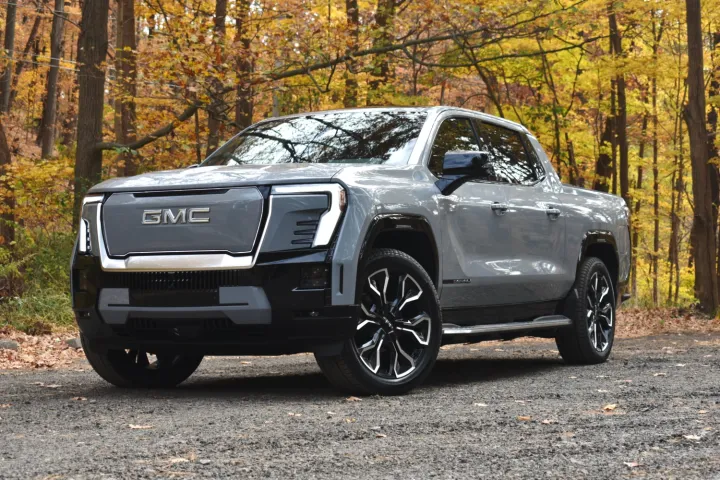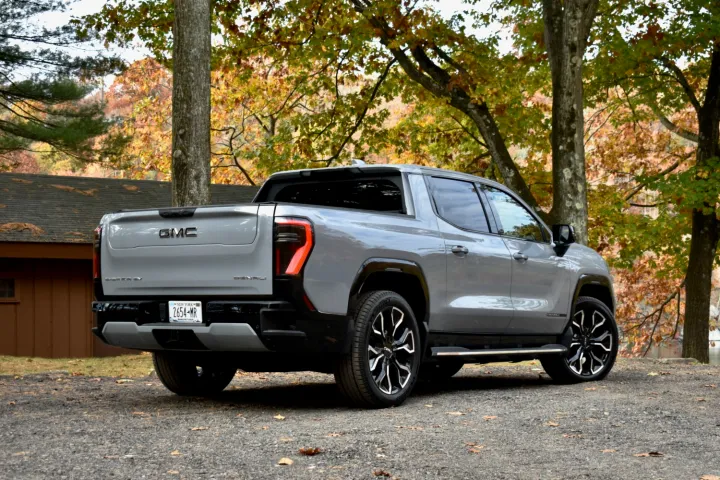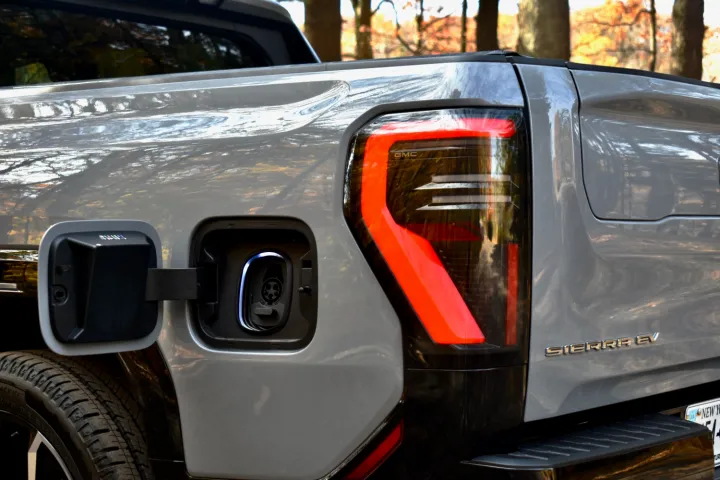
2024 GMC Sierra EV
MSRP $99,945.00
Pros
- Distinctive styling
- Excessive power
- Comfortable ride
Cons
- No Apple CarPlay
- Still drives like a truck
- Interior not quite up to Denali standards
- Inefficient
 Stephen Edelstein / Digital Trends
Stephen Edelstein / Digital TrendsElectric vehicles might spell the end for tailpipe emissions, but the major United States automakers don’t want them to spell the end for the highly profitable full-size pickup trucks that are the cornerstone of their business.
So it was inevitable that General Motors would launch a GMC Sierra EV to complement the Chevrolet Silverado EV. Like its internal-combustion counterpart, the Sierra EV is mechanically identical to its Chevy sibling, but features different styling a lineup that tilts more toward luxury and higher transaction prices. It also makes GMC the only U.S. brand with multiple electric pickups, as the Sierra EV shares showroom space with the GMC Hummer EV. Given GMC’s history as one of the first electric truck-makers, it’s fitting that this sometimes-overlooked brand can make that claim today.
The 2024 GMC Sierra EV arrives exclusively in high-end Denali Edition 1 guise with a base price of $99,945. That buys every feature on the menu, plus rarity, as 2024-model-year production is very limited. GMC plans to boost production and fill out the lineup with other trim levels for 2025.
Design and interior
 Stephen Edelstein / Digital Trends
Stephen Edelstein / Digital TrendsGMC’s designers combined futuristic styling with the staggering bulk of modern full-size pickup trucks to create a vehicle that is proudly electric while still catering to existing truck buyers, who are used to big vehicles. With its array of lights, including the illuminated silhouette of a grille, glowing GMC logo, and fender lights, the Sierra EV looks like a life-size toy truck. It also looks more distinct from its internal-combustion counterpart than the related Chevy Silverado EV.
Both the Chevy and GMC trucks are clean-sheet designs based on a completely different architecture from internal-combustion trucks. While Ford repurposed existing bits to make the F-150 Lightning, GM relied on the same component set as its other EVs. So instead of a traditional ladder frame, the Sierra EV has a unibody structure more like a passenger car, with the battery pack as an integral part of that structure.
This means that, unlike the internal-combustion Sierra, the electric model is essentially locked into one body style. But it’s the most popular one for pickups: a four-door crew cab. The Sierra EV’s 5.8-foot bed also matches the shorter of the two options for the standard Sierra crew cab, with a mid-gate pass-through that allows the bulkhead between the cab and bed to be lowered to make room for longer items. Introduced by GM in the early 2000s, this feature is great as long as you’re willing to futz with movable panels and keep an eye on your truck at all times, as the mid-gate leaves an open space between the cab and bed.
The Sierra EV looks like a life-size toy truck.
There’s not downside to the Sierra EV’s frunk, as covered storage space is always appreciated in a pickup. The Sierra EV also shares the reconfigurable Multi-Pro tailgate with non-electric models. This can be opened partway to better secure items that may hang out past the end of the bed, or fully like a conventional tailgate.
Overall length and wheelbase are similar to a comparably configured internal-combustion model, but our Denali Edition 1 test truck was about 2 inches wider. That still translates to less second-row headroom and legroom than a non-electric Sierra, however.
The interior itself is best described as austere luxury. GMC’s Denali trucks have generally avoided the cliché Western themes of other high-end trucks, giving their cabs a classier look. But, shorn of any distinguishing features in an attempt at typical EV minimalism, the Sierra EV Denali’s mostly-black interior didn’t have much to make it feel special. And the liberal use of plastic confirmed the stereotype of chintzy GM interiors.
Tech, infotainment, and driver assist
 Stephen Edelstein / Digital Trends
Stephen Edelstein / Digital TrendsInterior materials may not quite live up to the Denali billing, but this big truck at least gets a big screen to match its considerable size.
The 16.8-inch touchscreen essentially copies the format of the Ford F-150 Lightning, with portrait orientation and a large central knob as the main analog touchpoint. GMC also includes a row of hard buttons at the bottom as well, which makes using the climate control a bit easier, and groups frequently-used icons like navigation, audio, and the home button at the upper-left corner of the screen where it’s easy for the driver to reach them. However, as with other recent GM vehicles, the headlight controls are only accessible via the screen. You also have to use the screen to turn the truck off — and it’s easy to lose track of both icons.
The liberal use of plastic confirmed the stereotype of chintzy GM interiors.
An 11.0-inch digital instrument cluster and 14.0-inch heads-up display are also standard, while the infotainment system itself is Google-based. It includes built-in Google Maps, Google Assistant, and Google Play Store apps, much like the systems that have been available in Volvo and Polestar EVs for a few years now. But GM has opted not to include Apple CarPlay, or standalone Android Auto, with its systems. The Google services are also subscription-based, although 2024 Sierra EVs come with eight years of connectivity.
For 2024, the Sierra EV also comes standard with expected driver aids like forward-collision warning, automatic emergency braking (front and rear), and adaptive cruise control, plus the hands-free Super Cruise highway-driving system. Super Cruise continues to impress with its smoothness and reliability, although the automated-lane change function can be a bit over-eager. Super Cruise is also a subscription-based item, with three years included in this case.
Driving experience
 Stephen Edelstein / Digital Trends
Stephen Edelstein / Digital TrendsLike other electric truck makers, GMC applied a big dollop of speed and power to help win over skeptical customers. The Sierra EV Denali Edition 1’s dual-motor powertrain sends 754 horsepower and 785 pound-feet of torque to all four wheels. GMC estimates a zero to 60 mph time of 4.5 seconds, about the same as what Ford estimates for the F-150 Lightning. But it’s well behind the 2.6-second time Tesla claims for the tri-motor Cyberbeast version of its Cybertruck, as well as most versions of the Rivian R1T.
None of these trucks need to be that quick. Sports-car acceleration isn’t exactly a priority for traditional truck buyers, after all. And while it does get out of its own way nicely, the Sierra EV’s immense size blunts the subjective feeling of acceleration. It’ll still put a smile on your face, but perhaps a smaller one than the spec sheet suggests.
In normal driving, quick acceleration is also the Sierra EV’s only trick. When you’re not surprising Porsche 911 drivers, the driving experience is very much like any other truck. The Sierra EV does not like to change directions in a hurry, and we noticed a surprising amount of shuddering over bumps considering that this isn’t a traditionally-built truck with a separate frame. The Denali Edition 1 version’s standard air suspension did at least provide comfortable ride even with the massive 24-inch wheels that are also standard on this model.
The driving experience is very much like any other truck.
Four-wheel steering is also standard on the Denali Edition 1, but while it makes parking-lot maneuvering a lot easier it doesn’t do much at higher speeds. The four-wheel steering system also enables the CrabWalk feature from the GMC Hummer EV, allowing the Sierra EV to drive diagonally at low speeds. It’s definitely fun, but we can’t think of a practical, real-world application for this. You definitely won’t be CrabWalking through your daily commute.
Any concerns about stopping a big, heavy pickup with the horsepower of a supercar were erased by the Sierra EV’s regenerative braking system. GMC offers normal, strong, and off settings, with the normal setting more than adequate for regular use. We barely had to touch the brake pedal. Like other GM EVs, the Sierra also lets the driver temporarily call up additional regen with a steering-wheel paddle, a bit like using the engine braking in a combustion vehicle.
GMC estimates around 10,000 pounds of towing capacity for 2024 Sierra EV models, matching the Ford F-150 Lightning and exceeding the 7,500 pounds of the Sierra’s GMC Hummer EV stablemate. The Rivian R1T and Tesla Cybertruck can both tow up to 11,000 pounds, but in all cases, towing such heavy loads with an EV can be tricky given the limited number of charging stations that can accommodate a truck and trailer.
Range and charging
 Stephen Edelstein / Digital Trends
Stephen Edelstein / Digital TrendsIn Denali Edition 1 trim, the Sierra EV offers a GM-estimated 440 miles of range. But that’s achieved with an enormous 205-kilowatt-hour battery pack, not through efficiency. We averaged about 2.0 miles per kWh over a week of driving.
A big battery pack and an inefficient vehicle equal troublesome charging logistics. The Sierra EV is capable of 350-kilowatt DC fast charging, which can get the pack up to the standard 80% charge in a comparable time to other EVs under ideal conditions. But that’s assuming you can find one of the more powerful 350kW stations. At a less powerful station, it’s going to take a lot longer to refill so much battery capacity. And while it may be possible to use the Sierra EV without running the battery down too far most of the time, towing will deplete that range a lot faster.
Keeping it topped up may be a chore, but the pack does provide plenty of capacity for powering tools, electronics, or anything else you might need at a job site or camp site with the Onboard Power Station Pro system. This provides up to 10.2kW of offboard power, and GM is now marketing home-energy systems that let owners connect EVs to a stationary backup battery for use during power outages.
How DT would configure this car
 Stephen Edelstein / Digital Trends
Stephen Edelstein / Digital TrendsThe 2024 GMC Sierra EV is only available in fully-loaded Denali Edition 1 form, but that’s about to change for the 2025 model year. In addition to the Denali, which starts at $91,995 for 2025 with a smaller battery pack that still affords 390 miles of range, GMC is adding AT4 off-road and entry-level Elevation models that will likely be cheaper still.
These lower-priced models bring the Sierra EV more in line with other electric trucks, but customers will have to be very committed to the GMC brand to choose a Sierra EV over the others. Like the internal-combustion Sierra, the Sierra EV has to contend with a mechanically-identical Chevy Silverado sibling offering all of the same features, albeit with different styling that’s not as interesting.
Buyers who want a traditional full-size pickup that just happens to be electric should also consider the Ford F-150 Lightning, as the Sierra’s EV-specific design doesn’t separate it that much from the more old-school Ford. The Rivian R1T and Tesla Cybertruck offer more imaginative takes on what an electric pickup can be, although the Tesla’s compromised design and myriad build-quality issues make it more of a showpiece than a daily driver.
The Sierra EV falls somewhere in between those trucks. It has the look and engineering of a dedicated EV, but the feel of a conventional pickup. Despite the effort that went into its design, it seems more focused on keeping existing customers happy and keeping an existing brand relevant than doing something truly new or groundbreaking.




















 English (US) ·
English (US) ·